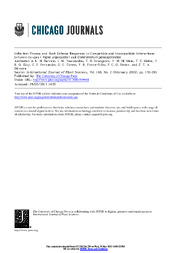Infection process and host defense responses in compatible and incompatible interactions between Cowpea (Vigna unguiculata) and Colletotrichum gloeosporioides.
Infection process and host defense responses in compatible and incompatible interactions between Cowpea (Vigna unguiculata) and Colletotrichum gloeosporioides.
Author(s): BARRETO, A. L. H.; VASCONCELOS, I. M.; GRANGEIRO, T. B.; MELO, V. M. M.; MATOS, T. E.; ELOY, Y. R. G.; FERNANDES, C. de F.; TORRES, D. C.; FREIRE FILHO, F. R.; FREIRE, F. das C. O.; OLIVEIRA, J. T. A.
Summary: The infection process of Colletotrichum gloeosporioides was examined by light microscopy on two cowpea genotypes, BR 3 Tracuateua and TE 97-411. In the susceptible genotype BR 3 Tracuateua, the pathogen acted as an intracellular hemibiotroph. Invasion of cowpea primary leaves occurred preferentially through the leaf epidermal cells by penetration tubes that emerged from appressoria. The penetration tube swelled within 48 h to form a spherical infection vesicle inside the epidermal cell in a biotrophic interaction. Subsequently, it became multilobed and multiseptated. By 4 d after inoculation, one or more large primary hyphae emerged from the lateral lobes and grew intracellularly and further colonized several adjacent epidermal host cells, characterizing the necrotrophic phase of infection. Primary leaves of the resistant cowpea genotype, TE 97-411, showed enhanced penetration resistance to C. gloeosporioides associated with higher epidermal H2O2 accumulation beneath appressoria and primary germ tubes, papilla formation, and increased phenylalanine ammonia-lyase activity, possibly related to accumulation of phenolic compounds and host cell wall lignification. Macroscopic examination of the primary leaves revealed the presence of shrunken necrotic lesions characteristic of anthracnose in infected BR 3 Tracuateua, whereas in the genotype TE 97-411, cell death was also observed but only in a reduced percentage of the infection sites. In summary, the results obtained in this study suggested that TE 97-411 is the resistant genotype to C. gloeosporioides compared with BR 3 Tracuateua because it developed more effective defense responses against the establishment of the pathogen.
Publication year: 2007
Types of publication: Journal article
Unit: Embrapa Mid-North
Observation
Some of Embrapa's publications are published as ePub files. To read them, use or download one of the following free software options to your computer or mobile device. Android: Google Play Books; IOS: iBooks; Windows and Linux: Calibre.
Access other publications
Access the Agricultural Research Database (BDPA) to consult Embrapa's full library collection and records.
Visit Embrapa Bookstore to purchase books and other publications sold by Embrapa.

